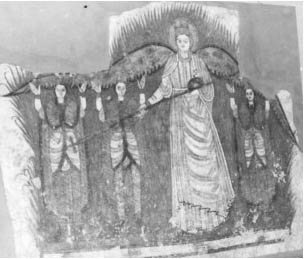HistoryThe Christianization of NubiaThe conversion of the Nubians to Christianity started during the reign of Queen Theodora of Byzantine, in the sixth century, through her missionary Presbyter Julian.1 The largest sum of information on the conversion activities in Sudan comes from the hearsay account of the Syrian scholar Ephesus, who never set a foot in Nubia. Since Ephesus was a Monophysite, like Queen Theodora, he opposed the Orthodox Church of Emperor Justinian. In his writings, he discredited the role of the Orthodox Church in converting the Nubians to Christianity. Instead, he gave the credit to the Monotheistic Church. Thus, Ephesus' account should be treated with caution.
According to Ephesus, Queen Thodora sent the missionary Julian to convert the Nubians. When Justinian heard of the news, he sent a missionary from Thebes in an attempt to reach Sudan ahead of Theodora's missionary. As soon as the Queen knew of Justinian's plan, she sent a message to the Duke of Thebes requesting from him to delay Justinian's missionary so that Julian would reach Sudan first. Accordingly, Julian arrived first and met with the king and princes of the kingdom of Nobatia, in Lower Nubia, who were described as welcoming and generous. As Ephesus tells it, the Nubian king immediately converted to Christianity and accepted to be baptized. The king then publicly announced his Christianity and confessed that "He is the one true God, and there is no other beside."2 Justinian later tried to convert the same king to the Orthodox faith, but the Nubian king preferred Monophytism.
Julian continued his mission to convert all the Nubians and ended up spending two years "though suffering greatly from the extreme heat." Bishop Longinus succeeded Julian in the difficult mission covering the kingdom of Nobatia and farther south to the kingdom of Alwa. Ephesus states that Bishop Longinus "baptized him (the king of Alwa) and his nobles and all his family; and the work of God grows daily."3 In a letter to Queen Theodora, the king of Nobatia tells her of his attempts to send Bishop Longinus to the Blemmeys. Known for their harshness and animosity towards foreigners, the conversion of the Blemmeys was a challenge to the Bishop. In any case, the Blemmeys eventually converted to Christianity, in the same century. Shortly afterwards, the royal house of Makuria converted. Christianity greatly changed the Nubian way of life including burial traditions.4 Following the Christianization of North Sudan, the Nubians began to bury their dead in tombstones. Uncovered tombstones in the territory of the Makurian kingdom reveal writings of Greek prayers related to the Orthodox Church. Thus, it is very possible that Makuria was later converted to the Orthodox faith. However, lack of historical evidence makes it difficult to make conclusive remarks regarding the various roles that the different Christian sects have plaid in Sudan.
Edited: Dec. 2008. |

